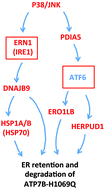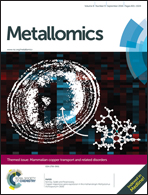A systems biology approach reveals new endoplasmic reticulum-associated targets for the correction of the ATP7B mutant causing Wilson disease†
Abstract
Copper (Cu) is an important trace element required for the activity of essential enzymes. However, excess Cu compromises the redox balance in cells and tissues causing serious toxicity. The process of disposal of excess Cu from organisms relies on the activity of Cu-transporting ATPase ATP7B. ATP7B is mainly expressed in liver hepatocytes where it sequesters the potentially toxic metal and mediates its excretion into the bile. Mutations in the ATP7B gene cause Wilson disease (WD), which is characterized by the accumulation of toxic Cu in the liver due to the scarce expression of ATP7B as well as the failure of ATP7B mutants to pump Cu and/or traffic to the Cu-excretion sites. The most frequent ATP7B mutant, H1069Q, still presents a significant Cu-transporting activity, but undergoes retention within the endoplasmic reticulum (ER) where the mutant is rapidly degraded. Expression of this ATP7B mutant has been recently reported to activate the p38 and JNK stress kinase pathways, which, in turn, trigger quality control mechanisms leading to the arrest of ATP7B-H1069Q in the ER and to the acceleration of its degradation. However, the main molecular players operating in these p38/JNK-dependent ER quality control pathways remain to be discovered. By using a combination of RNAseq, bioinformatics and RNAi approaches, we found a cluster of ER quality control genes whose expression is controlled by p38 and JNK and is required for the efficient retention of the ATP7B-H1069Q mutant in the ER. Silencing these genes reduced the accumulation of the ATP7B mutant in the ER and facilitated the mutant sorting and export to the Golgi and post-Golgi copper excretion sites. In sum, our findings reveal the ER-associated genes that could be utilized for the correction of ATP7B mutants and, hence, for the normalization of Cu homeostasis in Wilson disease.

- This article is part of the themed collections: Metallomics Recent HOT articles and Mammalian Copper Transport and Related Disorders

 Please wait while we load your content...
Please wait while we load your content...